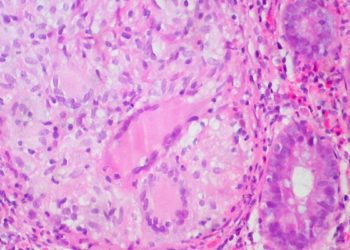2 Minute Medicine Rewind April 22, 2024
Postpartum breast cancer and survival in women with germline BRCA pathogenic variants
1. A cohort study focusing on the survival of women with young-onset breast cancer (YOBC) and BRCA pathogenic variants (PVs) found that all-cause mortality was greater amongst individuals with a YOBC diagnosis received between 5-10 years postpartum.
Evidence Rating Level: 1 (Excellent)
Young-onset breast cancer (YOBC) accounts for 10% of breast cancer (BC) cases in the United States and the United Kingdom and has a greater prevalence in other countries as well. Furthermore, there has been data supporting the theory that the postpartum period confers a higher risk period in which new cancers can both initiate and metastasize. To further characterize this risk, researchers recruited a cohort of 903 women with BRCA1/2 pathogenic variants. All-cause mortality was the primary outcome of the study with survival being calculated as the time from BC diagnosis to the time of death or last contact. A total of 903 women aged 45 or younger (mean [SD] age, 37.3 [5.4] years) with BC stage I-III were included with the mean follow-up time being 10.8 (9.8) years (IQR, 2.8-16.1 years). Within this group of women, 419 received their BC diagnosis 0 to under 10 years after childbirth. Mortality rates were higher in women diagnosed between 5 to less than 10 years after childbirth (hazard ratio [HR], 1.56 [95% CI, 1.05-2.30]) compared with women diagnosed 10 or more years after childbirth or nulliparous women. Once again compared to the nulliparous group, women in the ER-positive BC group (HR, 2.35 [95% CI, 1.02-5.42]) and ER-negative BC in the 5 or less group (HR, 3.12 [95% CI, 1.22-7.97]) had a higher risk of mortality. Individuals carrying the BRCA1 gene had higher mortality in the 5 to 10 years post-partum group (HR, 2.03 [95% CI, 1.15-3.58]). Overall, there was a strong association between YOBC with BRCA PVs and increased risk of all-cause mortality when diagnosed between 5 to 10 years postpartum. The highest risk was ER-positive BC diagnosed within 5 years postpartum and ER-negative BC diagnosed 5 to less than 10 years postpartum. Women carrying the BRCA1 gene had higher risks for poor outcomes when diagnosed 5-10 years postpartum. Further research into this area is required to determine whether or not screening guidelines should be adapted to address the risks of mortality and malignancy in the postpartum period.
1. In a cohort of patients with varying lung function assessed through values of FVC and FEV1, and no previous depression, participants with the lowest lung function had increased depression levels, compared to individuals with better levels of lung function.
Evidence Rating Level: 1 (Excellent)
Depression is a mental health condition that contributes to disability-adjusted life years and may lead to an increased risk of developing negative health outcomes. Identifying a cost-effective strategy to prevent depression is needed, as the current ones are costly and have limited efficacy. Physical health is one modifiable protective factor for depression, with only some parts of it being understood. One aspect still not understood is the role of lung function in preventing depression. Due to the lack of previous evidence, researchers in this prospective cohort study investigated the association between lung function and depression, looking at the mechanisms behind the possible association. A large group of participants with complete lung function (N= 353,243) were taken from the UK Biobank (UKB). A spirometry test was performed on the eligible participants to assess their respiratory function. A normal lung function was considered to be FEV1 ≥ 80% and FEV1/FVC ≥ 0.70, while all individuals who did not meet this criteria had impaired lung function. To compare characteristics’ values at baseline, such as depression or lung function, Wilcoxon tests for continuous variables [mean (SD)] or chi-square tests for categorical variables [frequency (%)] were used. Also used were Cox proportional hazard models as these could estimate the risk of new-onset depression resulting from impaired lung function. There was a nonlinear dose-response relationship between depression risk and lung function (nonlinear P < 0.05 for FVC and FEV1). The hazard ratios (HRs) of depression for FVC (% predicted) were 0.874 (95% CI=0.827-0.924; P < 0.001) for the 2nd quartile, 0.888 (95% CI = 0.839-0.940; P < 0.001) for the 4th quartile, and 0.880 (95% CI = 0.830-0.933; P < 0.001) for the lowest quartile. The HRs of depression for FEV1 were done as well and were 0.903 (95% CI = 0.855-0.954; P < 0.001) for the 2nd quartile, 0.860 (95% CI = 0.813-0.911; P < 0.001) for the 4th quartile, and 0.854 (95% CI = 0.805-0.905; P < 0.001) for the lowest quartile. The risk of developing depression was 12.4% (HR = 1.124, 95% CI = 1.074-1.176) higher in participants with impaired lung function. Biomarkers involving systemic inflammation, erythrocytes, and liver function could be mediators for depression in those with impaired lung function. Overall, damaged lung function was associated with a higher risk of developing depression. Regular screening for lung function may have a role in identifying at-risk populations and then developing individualized interventions.
Appendicitis hospitalization care costs among patients with delayed diagnosis of appendicitis
1. In a cohort of individuals who underwent an appendectomy, those with a delayed diagnosis had higher hospital costs than those diagnosed at a normal time.
2. Hospital care costs for appendicitis were higher among non-Hispanic Black individuals than non-Hispanic White individuals.
Evidence Rating Level: 1 (Excellent)
Delayed appendicitis has been associated with worse outcomes along with a longer hospital stay and increased appendectomy time. It is unknown if delayed diagnosis is associated with higher hospital costs related to appendicitis. To address this gap in the literature, researchers sought to further characterize hospital care for appendicitis and the differences relating to delayed diagnosis. Thus, the study enrolled participants between the ages of 18 to 64 years who had previously undergone a laparoscopic appendectomy for appendicitis. Hospital care costs for aggregated appendicitis were the primary outcome with the hospital perspective being used. The cohort included 76 183 participants (2192 Asian or Pacific Islander [2.9%], 14 132 Hispanic [18.5%], 8195 non-Hispanic Black [10.8%], 46 949 non-Hispanic White [61.6%]) who had previously received an appendectomy, with only 2045 (2.7%) having a delayed diagnosis. Patients who had a delayed diagnosis had a median (IQR) unadjusted cost of $11 099 ($6752- $17 740) compared to a cost of $9177 ($5575-$14 481) for the nondelayed group (P<.001). Specifically, the median (IQR) cost was higher in the non-Hispanic Black individuals with a nondelayed diagnosis ($13 027 [$8004-$19 947]) compared to non-Hispanic Black individuals with a delayed diagnosis ($10 650 [$6471-$17 074]). Appendicitis hospital cost was 1.23 times (95% CI, 1.16-1.28 times) higher in the delayed diagnosis group after controlling for confounding factors such as sex, ethnicity, and income quartile. Non-Hispanic Black individuals made up a greater proportion of the delayed diagnosis cohort and had 1.22 times (95% CI, 1.17-1.28) higher appendicitis cost than non-White Hispanic individuals. Delayed appendicitis diagnosis and as a result, worse quality health care is more prevalent in racial and ethnic minority groups. Finding ways to reduce delayed diagnosis could help hospitals reduce their overall costs of care. Overall, higher hospital costs were associated with a delayed diagnosis of appendicitis, with the highest costs being unequally distributed to minority groups.
1. In patients with obesity who had previously undergone a sleeve gastrectomy and are in the early phases of recovery, circulating levels of adipokines, particularly Nrg4, help alleviate hepatic steatosis resulting from metabolic dysfunction-associated steatotic liver disease (MASLD).
Evidence Rating Level: 3 (Average)
One challenge facing health care systems is metabolic dysfunction-associated steatotic liver disease (MASLD). Metabolic and bariatric surgery (MBS) remains an effective mechanism to help MASLD as it has weight-loss dependent and independent positive effects with multiple organs benefiting from the metabolic reprogramming it provides. Adipokines have been a popular choice for diet-induced hepatic steatosis, resulting from their potential for diagnosis and treatment. As a result, this case-control study was created to evaluate the effects of the three most commonly used adipokines (Nrg4, leptin, and adiponectin) during the early recovery phase after a sleeve gastrectomy (SG). To assess the effects of the medications, individuals with MASLD, a BMI ≥ 30 kg/m2, and who underwent laparoscopic SG were recruited in Shanghai. As this is a case-control study, individuals without an obese BMI and MASLD were recruited as the controls. An enzyme-linked immunosorbent assay (ELISA) was used to measure the levels of rg4, leptin, and adiponectin. Before the cases had SG, they had hepatic steatosis (p<0.001), hepatic dysfunction (i.e. ALT, AST, GGT; all p values < 0.001), dyslipidemia (i.e. TC, TG, HDL-c, LDL-c; all p values < 0.01 except TC), and dysglycemia (i.e. fasting glucose, fasting insulin, HOMA-IR; all p values ≤0.001). After surgery, the liver/spleen CT value ratio (LSR) increased (p=0.011) while there were no significant improvements in liver function indicators such as ALT (p=1.000), AST (p=0.299) or GGT (p=0.08). On the other hand, lipid and glucose metabolism levels decreased (i.e. TC, p=0.002; TG, p=0.032; fasting glucose, p=0.009; fasting insulin, p=0.036; HOMA-IR, p=0.013). In all, treatment with Nrg4 alleviated symptoms of MASLD.
1. In a randomized control trial of women with HIV, both treatment groups had similar adherence to prevention of mother-to-child HIV transmission (PMTCT) clinic visits, or ART administration at 6 weeks, 12 months, and 24 months.
2. At 2 years postpartum, women in the FLC intervention group had better adherence to PMTCT than women in the SOC intervention group.
Evidence Rating Level: 1 (Excellent)
Prevention of mother-to-child HIV transmission (PMTCT) is a huge part of the ongoing fight against HIV/AIDS. Option B+ recommends all women who are breastfeeding or pregnant to take triple ART regardless of their immune status, and newborns should take Nevirapine or Zidovudine for the first 4-6 weeks of life. This treatment has previously been recommended by the World Health Organization as the treatment option for PMTCT. However, there have been challenges adhering to option B+ especially in low-resource countries. To address these issues, a randomized control trial was conducted to see the comparison between PMTCT appointment adherence and ART at different time points postpartum. The participants were randomly assigned to either “Friends for Life Circles” (FLC) or to the MOH standard of care (SOC); two different peer support groups. Once again, the women were randomized in a 1:1 ratio to either the FLC experimental group or the SOC control group. Any infant born to a mother participating in the study was then enrolled and given daily Nevirapine from birth to 6 weeks of age. PMTCT appointment adherence at 6 weeks, 12 and 24 months postpartum, along with option B+ ART adherence at 6 weeks, 6 and 24 months postpartum, and continuation in care at the end of the study were the primary outcomes. A total of 540 eligible participants were randomly assigned to the intervention or control group until each group had 270 individuals. Both groups had a high care retention with 83.0% of participants remaining in care by the end of the follow-up period. However, more individuals were remaining in care in the FLC arm (86.7%) compared to the SOC arm (79.3%, p=0.0221). On the other hand, more women in the SOC arm (n=27, 10.0%) compared to the FLC arm (n=12, 4.4%) terminated care due to relocation. Compared to the FLC arm, more participants in the SOC arm dropped out from care (aHR=2.363, 95% CI: 1.199-4.656, p=0.013). Participants in rural communities along with participants between the ages of 15-24 were less likely to continue compared to their urban (p=0.015) and older counterparts (p=0.099) respectively. Overall, interventions providing group support and income-generation activities, such as the FLC intervention, may lead to people continuing with PMTCT care, higher rates of HIV-free children born to mothers with HIV, and the elimination of mother-child HIV transmission (EMTCT).
Image: PD
©2024 2 Minute Medicine, Inc. All rights reserved. No works may be reproduced without expressed written consent from 2 Minute Medicine, Inc. Inquire about licensing here. No article should be construed as medical advice and is not intended as such by the authors or by 2 Minute Medicine, Inc.







